| Your browser is not supported. | ||
|
Please browse our site using any of the following options:
| ||
How to recover a bogged 4WD vehicle
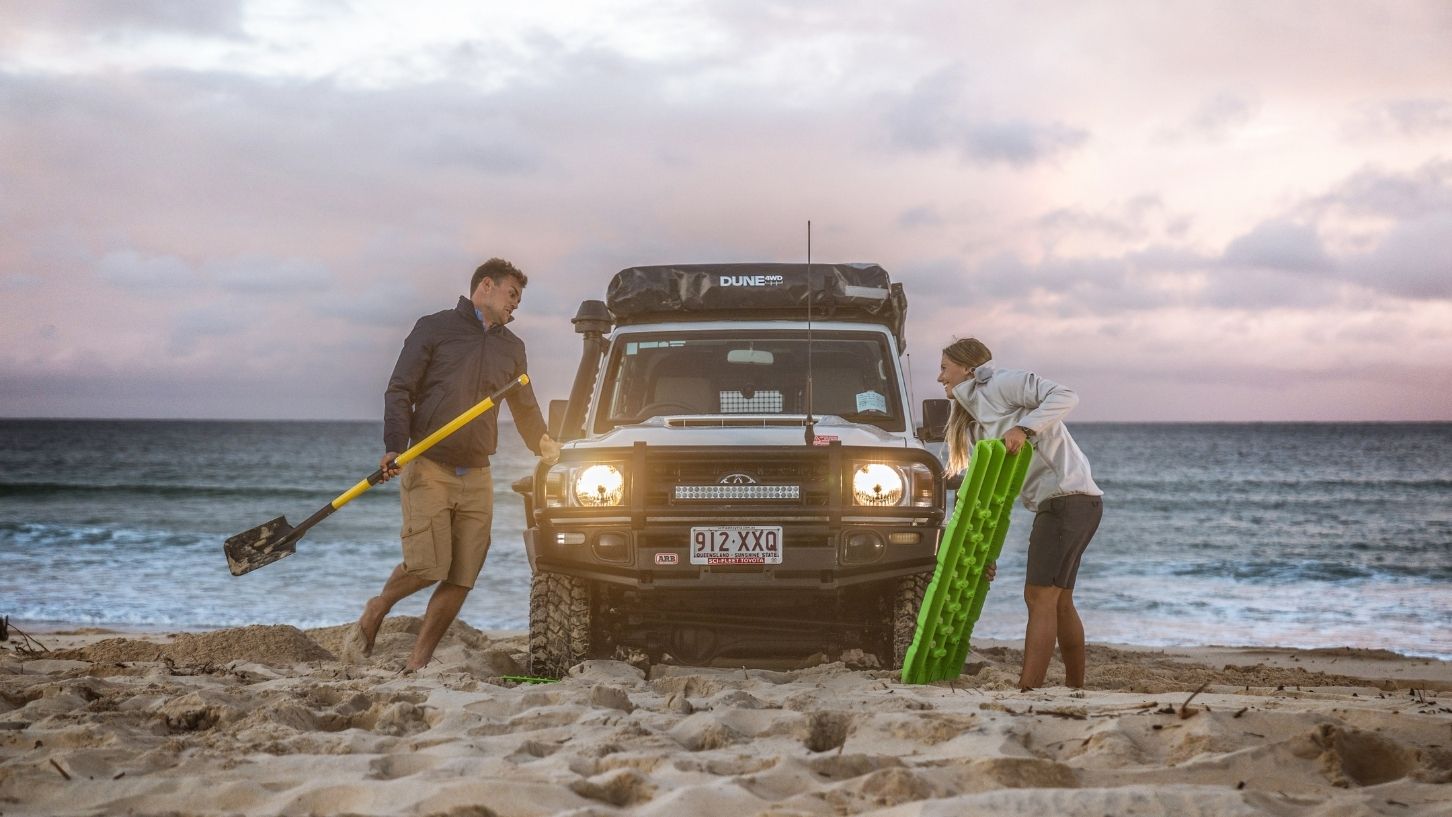
With the highs of jumping into a 4WD and exploring areas the everyday passenger car just isn't built to reach, come the lows of something that happens to every 4WD enthusiast, getting bogged.
You may have driven a range of different vehicles across your lifetime and have many years of experience behind the wheel. However, if you're new to off-roading, the chance of finding yourself in an emergency with a bogged 4x4 is very real. In other words: it pays to be prepared.
4WD Recovery Equipment You’ll Need
If your intention from the get-go is to enjoy some serious 4WD adventuring, having a high-quality 4WD winch fitted is worth the investment. Being able to winch yourself out of a sticky spot can be an effective way of getting back on track and arriving safely at your destination. But relying on a winch should never be your first option. There are some real and present dangers associated with using a winch, so make sure you try other alternatives listed below first.
Along with fitting a winch, know your 4WDs clearance heights before you leave home. The higher the ground clearance, the rougher the terrain you'll be able to negotiate without scraping parts of your vehicle against the ground and rocks on hill climbs and uneven tracks. Knowing the front and rear 4WD recovery points will also help you get out of trouble without damage if you need to be towed or winched to safety.
Never leave home without packing these must-have safety items in your car or trailer:
- Recovery tracks (also known as recovery boards)
- 4WD tyre pressure deflator with gauge and portable 4WD air compressor
- A jack
- A 4WD shovel
- A phone/GPS charger
- A pair of protective gloves
- A tyre repair kit
As your off-road driving skills improve, you'll be able to add or remove items from your recovery kit based on what works best for your preferred 4WD tracks and terrain around your favourite camping spots. However, as a beginner, these items should be considered your non-negotiable travelling companions:
Recovery tracks
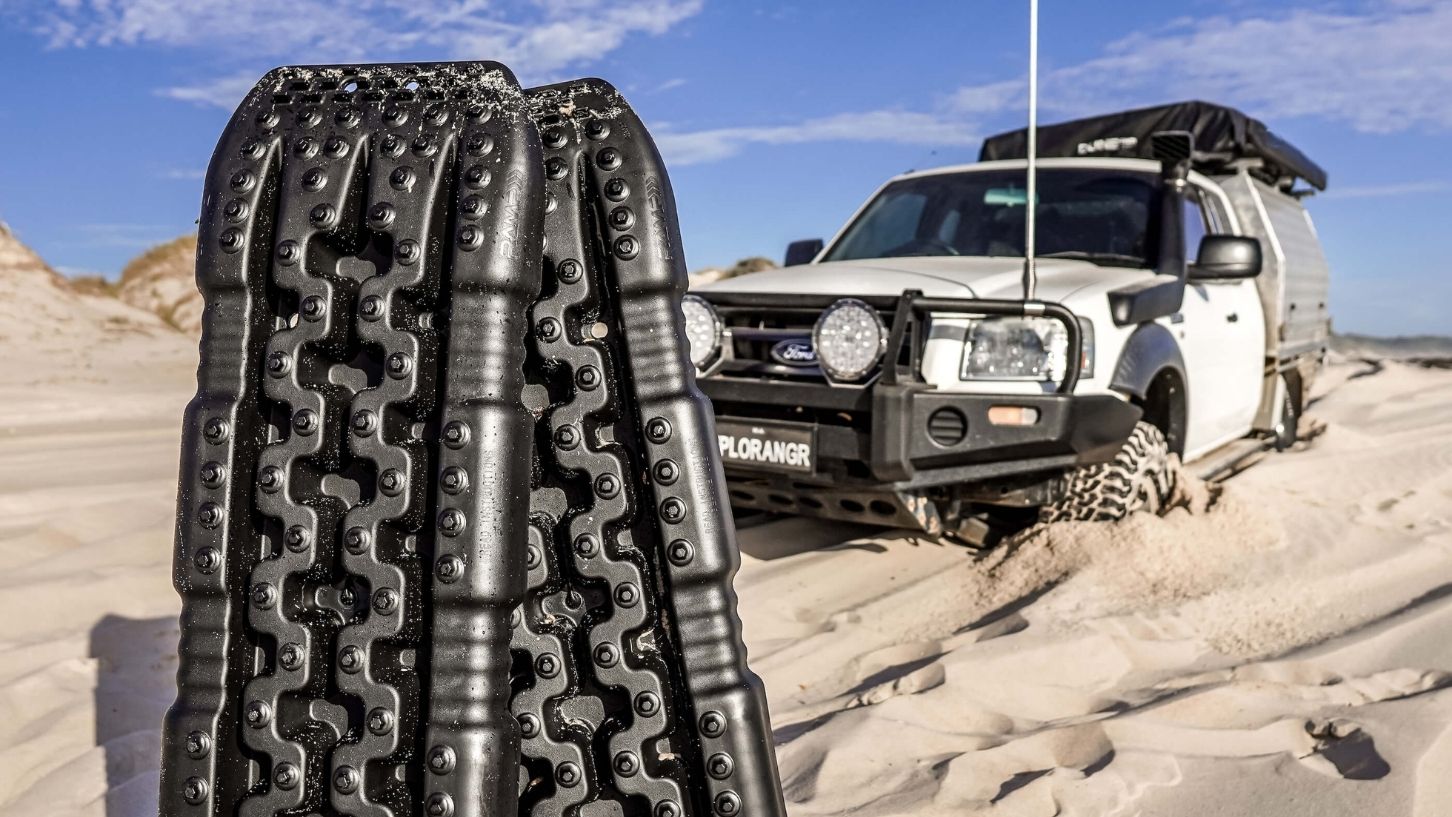
4WD recovery tracks are an essential part of your recovery kit. Recovery tracks, also known as recovery boards, give your tyres the traction they need to get you out of sticky situations. They can also play a role in helping winch your 4WD (or someone else's) to safety.
Tyre pressure deflator & portable air compressor
Always pack a tyre deflator (with an inbuilt gauge) for dropping your tyre pressures as well as a portable air compressor for increasing your tyre pressures as required. The reason for deflating your tyres when your car is bogged is for increasing the surface area of your tyres. When deflated, there is more surface area in contact with the ground, which helps the tyres have more traction.
Jacks
A high lift jack that's weight-rated to safely lift your 4WD for tyre changing, placing recovery tracks or boosting wheels suspended in a crevice is also vital - so don't leave home without one. If you plan on doing a lot of sand driving and don’t plan on ending up with a beached car, you might also want to consider a jack base specifically for use in sandy conditions.
Shovel
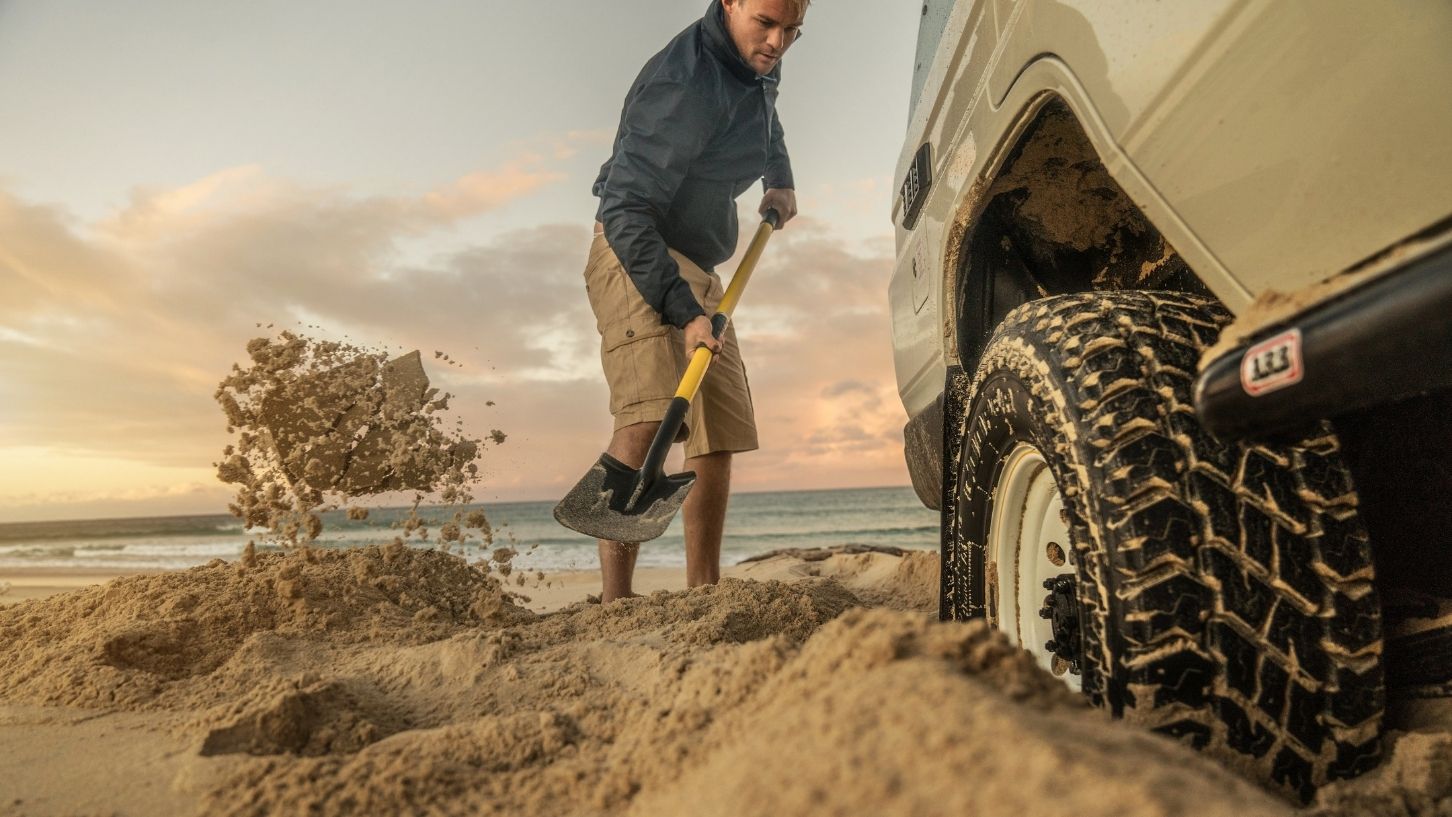
Although some 4WD recovery tracks double as shovels, having a purpose-designed shovel available can come in handy for digging sand, mud and snow from around tyres.
Phone/GPS charger
Being able to let emergency services or other cars in your travelling group know you're bogged and unable to recover yourself is important. Being low on battery charge is definitely a situation you'll want to avoid, so having plenty of spare battery power available is the answer.
Protective gloves
It's a good idea to always wear some form of protective gloves to avoid possible injury while recovering your bogged 4WD. A high-quality pair of protective gloves will protect your hands from broken glass and other sharp objects.
What To Do When Your 4WD Gets Bogged
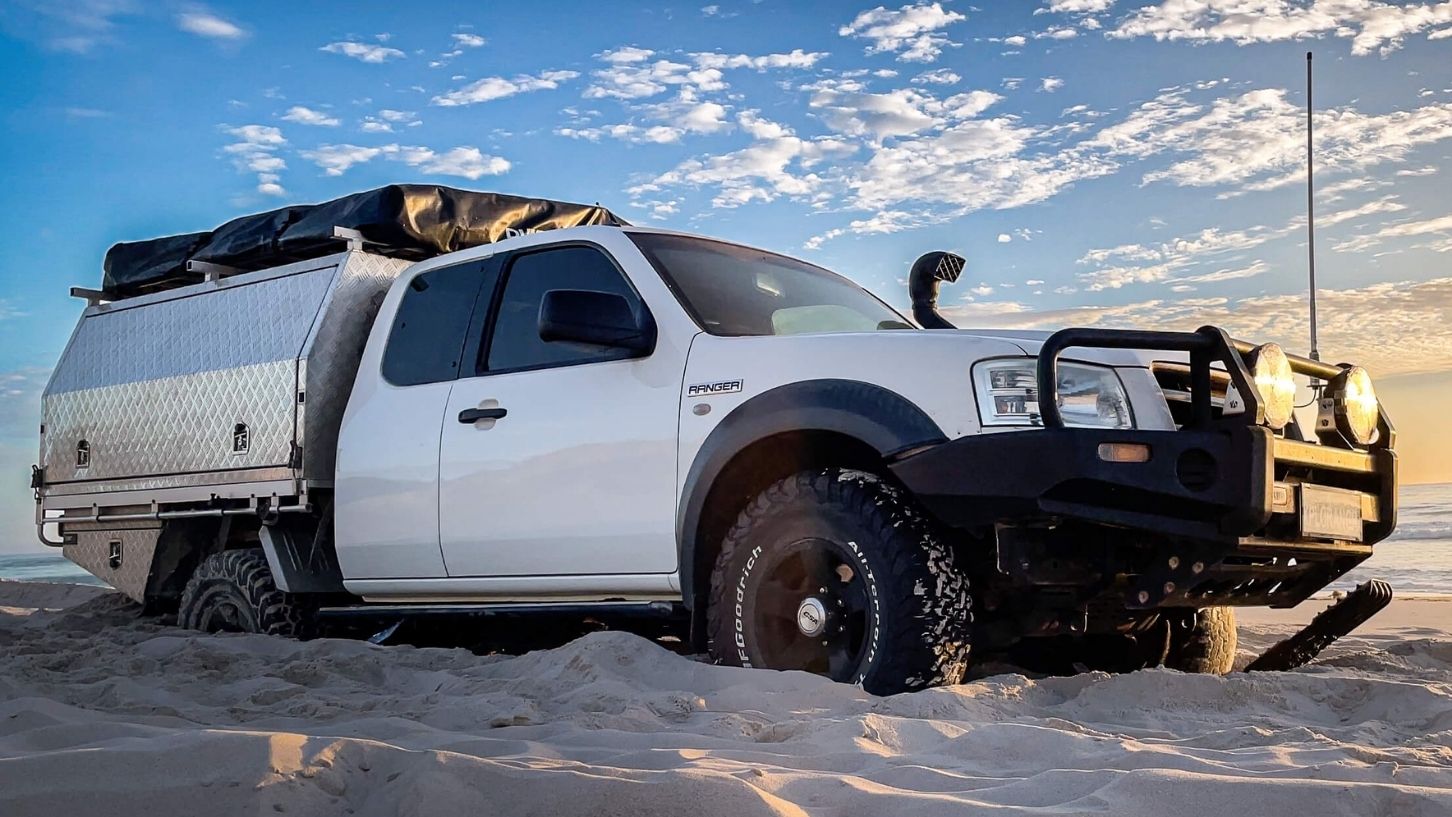
The first thing you should do when you have a beached or bogged 4x4 is to take a deep breath and relax. Sure, it's frustrating, but losing your cool won't get you unstuck any faster, and if anxiety takes hold, it's harder to think clearly enough to get yourself back on your way.
Don't jump on the accelerator and try spinning your way out of trouble. In most circumstances, you're only digging yourself (literally) into a deeper hole and making your eventual 4WD recovery tougher. Try reversing or driving forward slowly and turn the steering wheel to the left and right to see if the tyres can find some traction. If you can't generate any movement, stop driving.
Why is your 4WD bogged?
Next, get an understanding of why your 4WD is bogged. Knowing why you're bogged ensures you use the right recovery technique. There are three main causes that can lead to getting bogged: bottoming out, loss of traction and drivetrain faults:
1: Bottoming out
Getting stuck in ruts or channels in water crossings that run deeper than your 4WD height clearance, as well as rocks or tree stumps that exceed the height clearance, is known as bottoming out. Basically, one or more of your vehicle's wheels have lost contact with the ground and you're not going anywhere in a hurry.
2: Loss of traction
Your tyres can't grip a solid surface and move you forward or backwards. Spinning your wheels when you can't get traction may also lead to bottoming out. Tyres can also end up with too much mud or debris in the tread for them to grip and give you the traction you need.
3: Drivetrain faults
While they're made tough, some drivers find a way to test the limits of their 4WDs chassis or drivetrain. 4WDs rely on engine power being distributed evenly between the four wheels. If you snap an axle or wreck your CV (Constant-velocity) joint, apart from doing some serious damage to your vehicle, your recovery operation just got a whole lot more difficult.
4 Steps To Recovering A Bogged 4WD
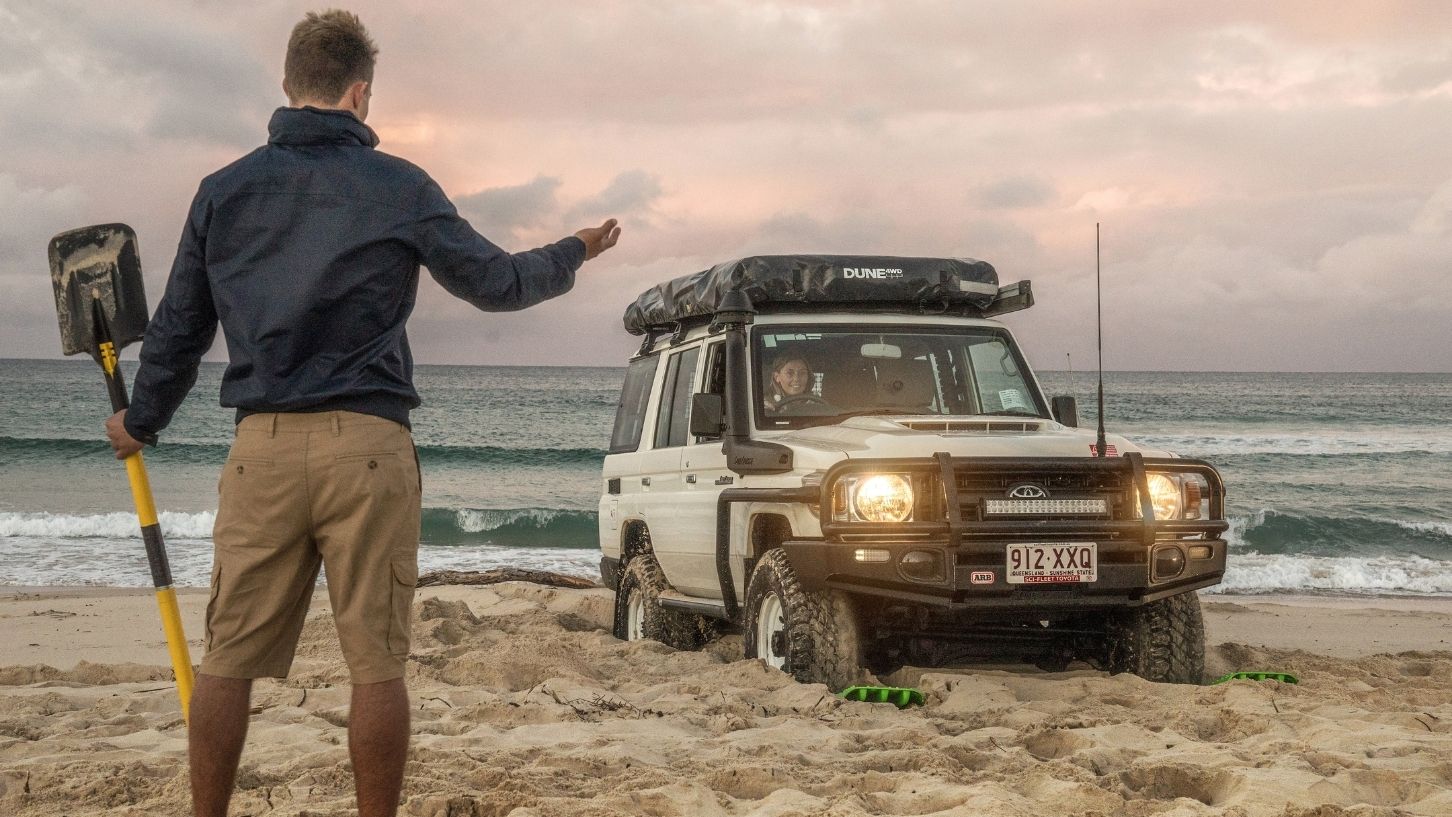
Not every situation is the same, but if you talk to seasoned 4WD experts, you'll find the following methods for getting your 4WD out of the muck are the safest and most effective.
1: Check your tyre pressure
Firstly, check that your tyre pressures are where they should be for the terrain (our handy 4WD tyre pressure guide will explain everything you need to know). Often, tyres won’t be getting enough grip on solid ground to give you the right level of traction. Dropping the psi (pounds-per-square-inch) in your tyres improves your traction level and can see you safely on your way in no time.
If you've already reduced the psi level in your tyres, try letting out some more air. For example, in sandy conditions, you can lower your air pressure to as low as 10psi per tyre. Always reinflate your tyres once you've cleared the bog.
2: Clear the tyres
Shovelling some sand or mud away from the tyres might give you just the right traction to drive out. After clearing away the muck, engage your differential lock (if you have one) and try accelerating slowly to get the wheels moving again. If you're no closer to getting out of the bog, stop spinning the wheels and turn to your recovery boards instead.
In cases where you've bottomed out on rocks, take a walk around and, if you can, take up a collection of smaller rocks and stones. Pile these up under and around the wheel that's lost contact with solid ground. This could provide the right amount of traction you need to get your vehicle's chassis off a rock or large boulder and get all four wheels back on solid ground.
3: Use 4x4 recovery tracks
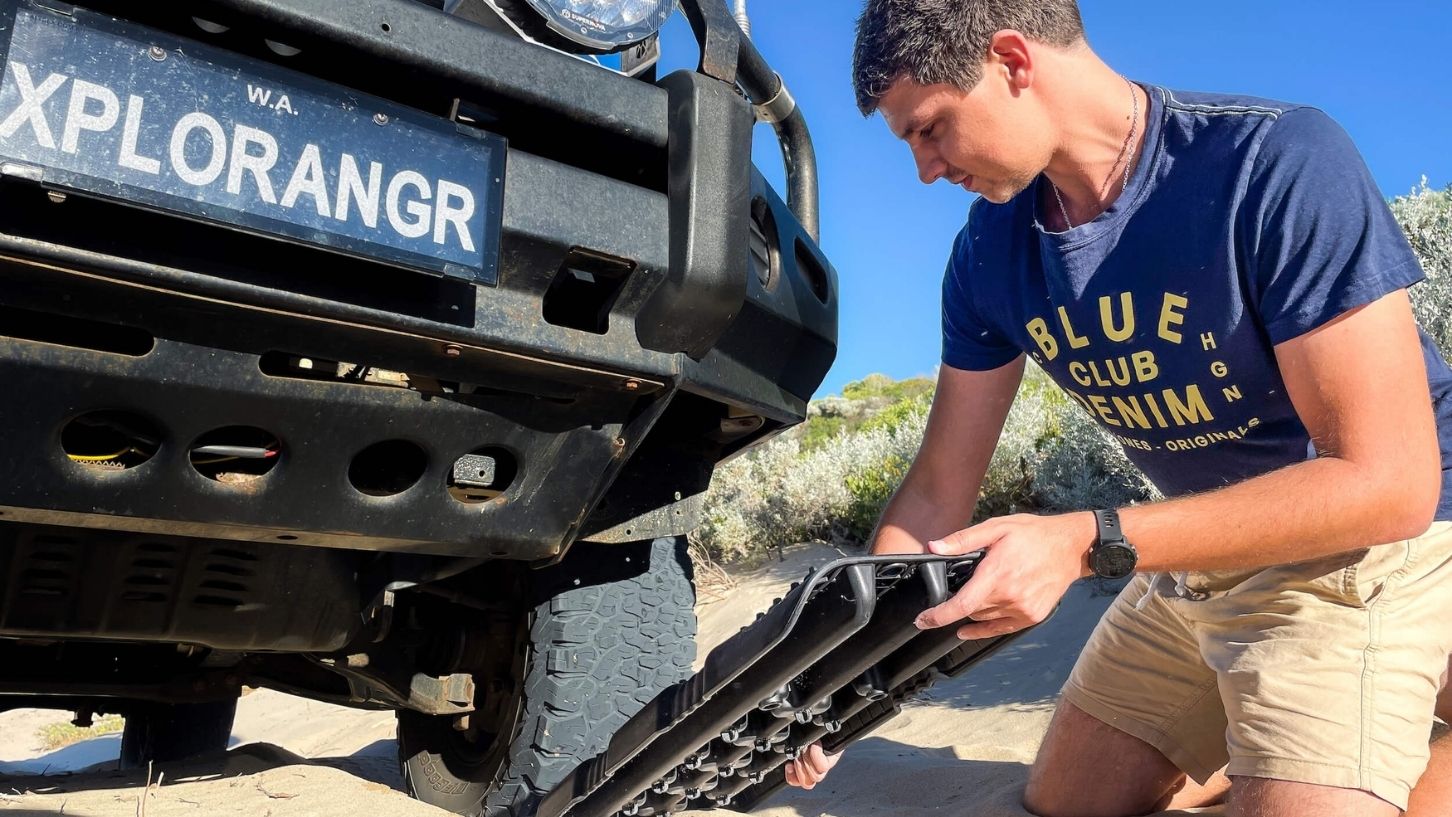
In many instances, recovery tracks or recovery boards are the best solution to a bogged 4x4. Grab your recovery tracks, and using your shovel, dig away the excess mud or sand (whichever is holding you in place). If there's a lot of mud in the tread of your tyres, clear some of that away as well. When you've cleared everything away from the tyre, wedge the recovery boards under the front part of the wheels.
The recovery boards should give you enough traction to move forward and regain traction. Again, engage your differential lock (if you have one), go easy on the throttle and gently move your vehicle forward and back onto solid ground.
4: Use snatch straps as a last resort
If you're still not getting enough traction, this is where you use your winch comes into play or you can get another vehicle in your group to essentially drag you out with a snatch strap. The dangers associated with snatch straps, both serious personal injury and damage to your 4WD are significant, so snatch straps should only ever be used as a last resort and always use a strap dampener.
Once your vehicle is free, increase your tyre pressures to a safe psi for the terrain. If you're unable to drive because of broken parts, contact an emergency assistance service or, if you're handy with mechanical work, do some repairs to make it to the next town or major campsite.
What NOT To Do When Your 4WD Is Bogged
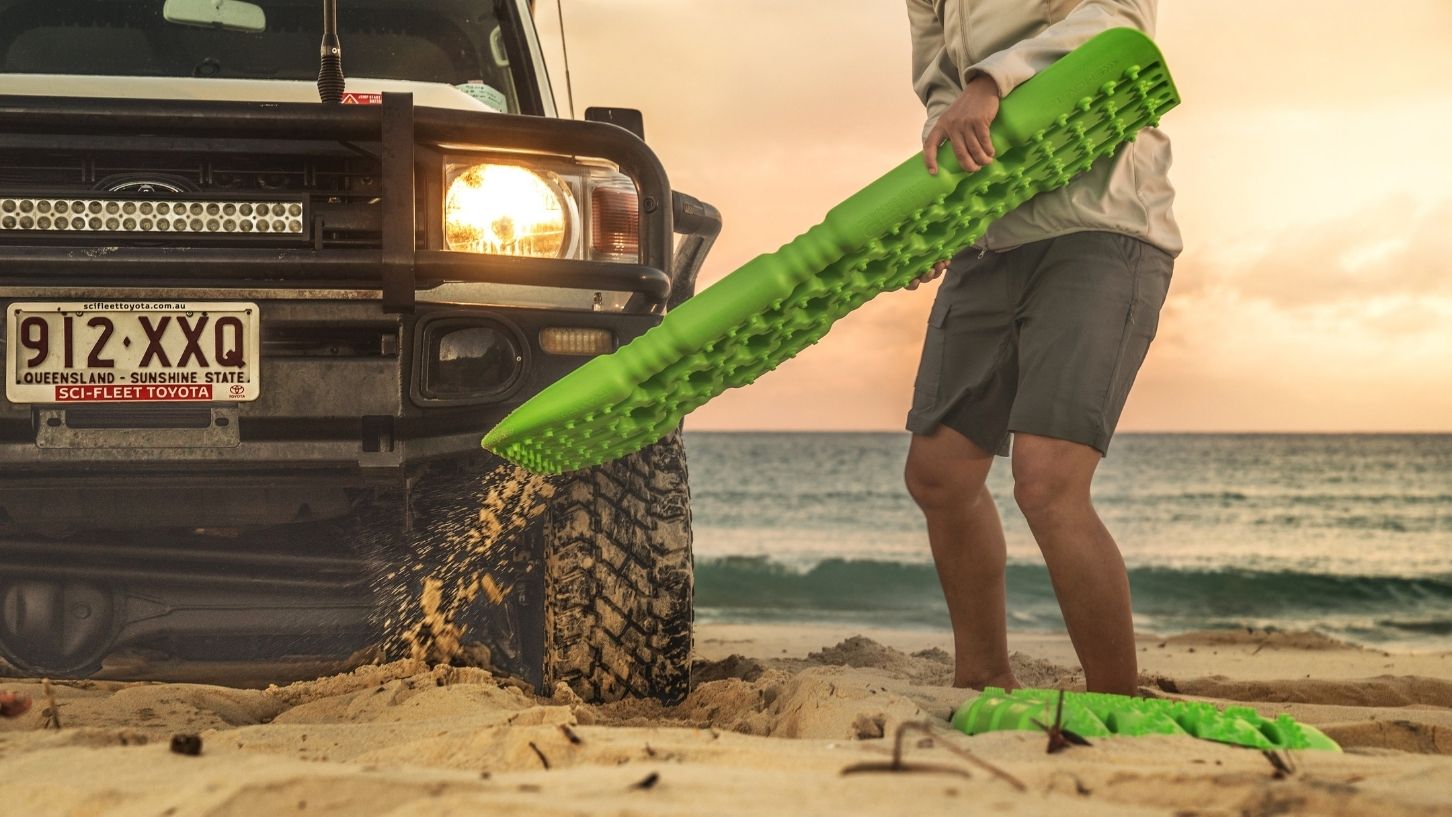
4WD recovery gone wrong - nothing ruins a fun off-road adventure faster than getting bogged and making it worse by doing the wrong thing. Now that you know what steps to take to getting your 4WD unbogged, here are some important factors to consider to ensure you aren’t making the wrong decision that could result in causing more headaches when bogged:
Don’t use the tow ball
If you are using a snatch strap or winch to recover your 4WD, don’t ever throw it over the tow ball and assume it will hold. The tow ball on your vehicle is actually brittle and isn’t designed to handle the amount of stress a winch or snatch strap will create when recovering a 4WD. The most likely outcome is that the tow ball will break off, or worse - snap off and send a chunk of metal hurtling through the air.
Don’t attempt recovery before using a shovel
Don’t be in a rush to get unstuck and jump straight into putting down your 4WD recovery tracks before shovelling. If the tyres aren’t clear and there is still sand, dirt or mud surrounding them, then you’ll be putting unnecessary force on your 4x4 recovery gear and reducing its effectiveness. It pays to spend five minutes using a shovel to dig around the tyres before attempting any kind of recovery.
Don’t ignore tyre pressure
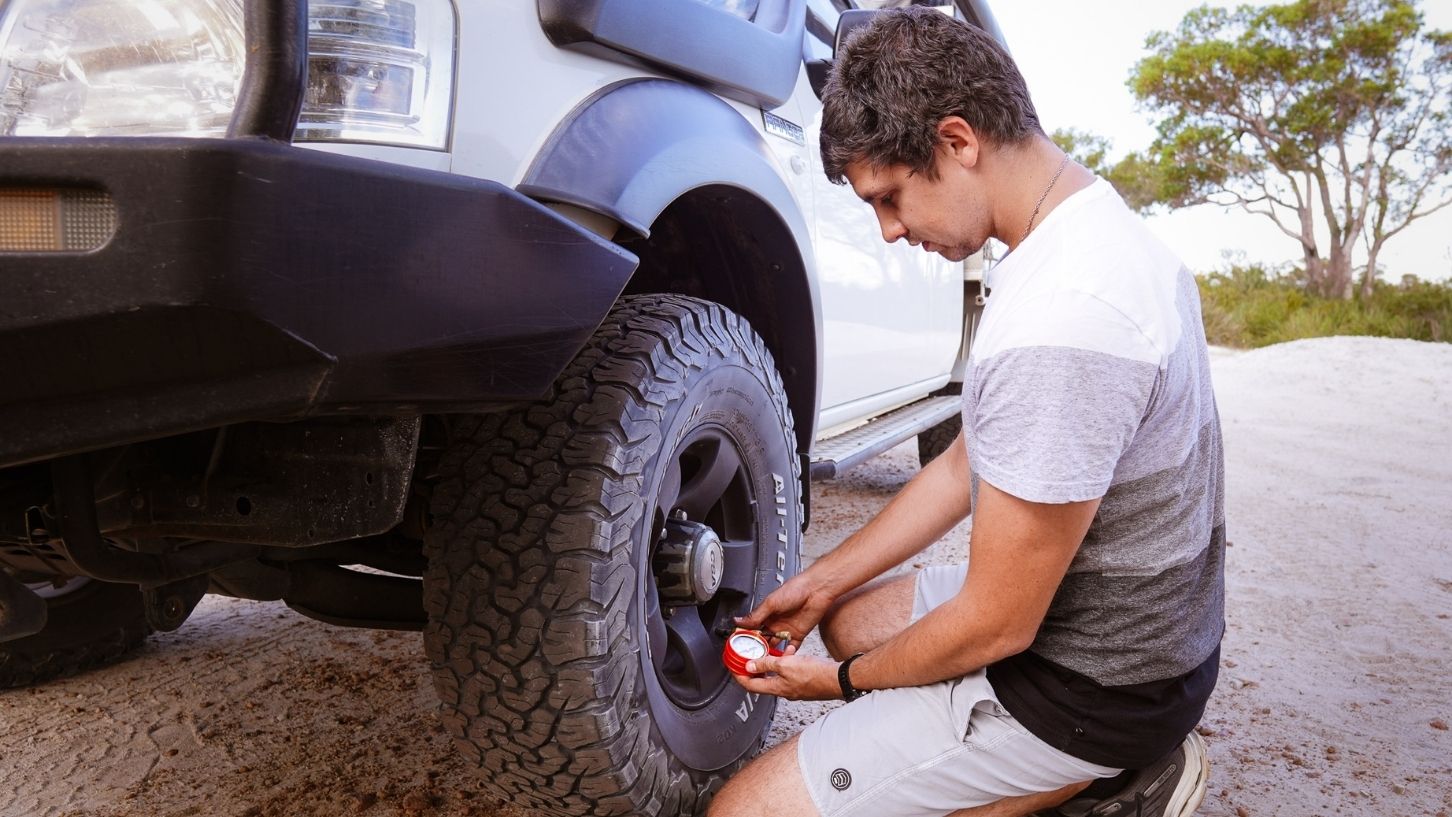
Again, don’t be in a rush and ignore basic steps such as checking the tyre pressure before starting a recovery. As one of the most crucial steps, lowering the pressure in your tyres will give them more traction to get out of a sticky situation. If they are at the wrong pressure, all you could be doing is spinning them and digging yourself into a deeper hole.
Don’t stand too close
Attempting a 4WD recovery is a high-risk situation, so standing too close to the vehicle is not a good idea. If you, your passengers or bystanders are standing too close during a recovery, it increases the chances of getting in the way and getting hit by the 4WD or by a piece of the recovery equipment if something goes wrong.
Don’t use recovery gear that isn’t designed for your 4WD
It may be tempting to buy a bunch of recovery equipment and think that it’s going to get you out of a tight spot - but if it isn’t suited for your type of vehicle, then you could be going nowhere fast. For example, if the snatch straps you purchased are too heavy for your type of 4WD, then they won’t be able to stretch enough to pull you out. This is why it’s crucial to always make sure every piece of 4WD recovery equipment you purchase is suited for your type of vehicle.
How To Avoid Bogging Your 4WD
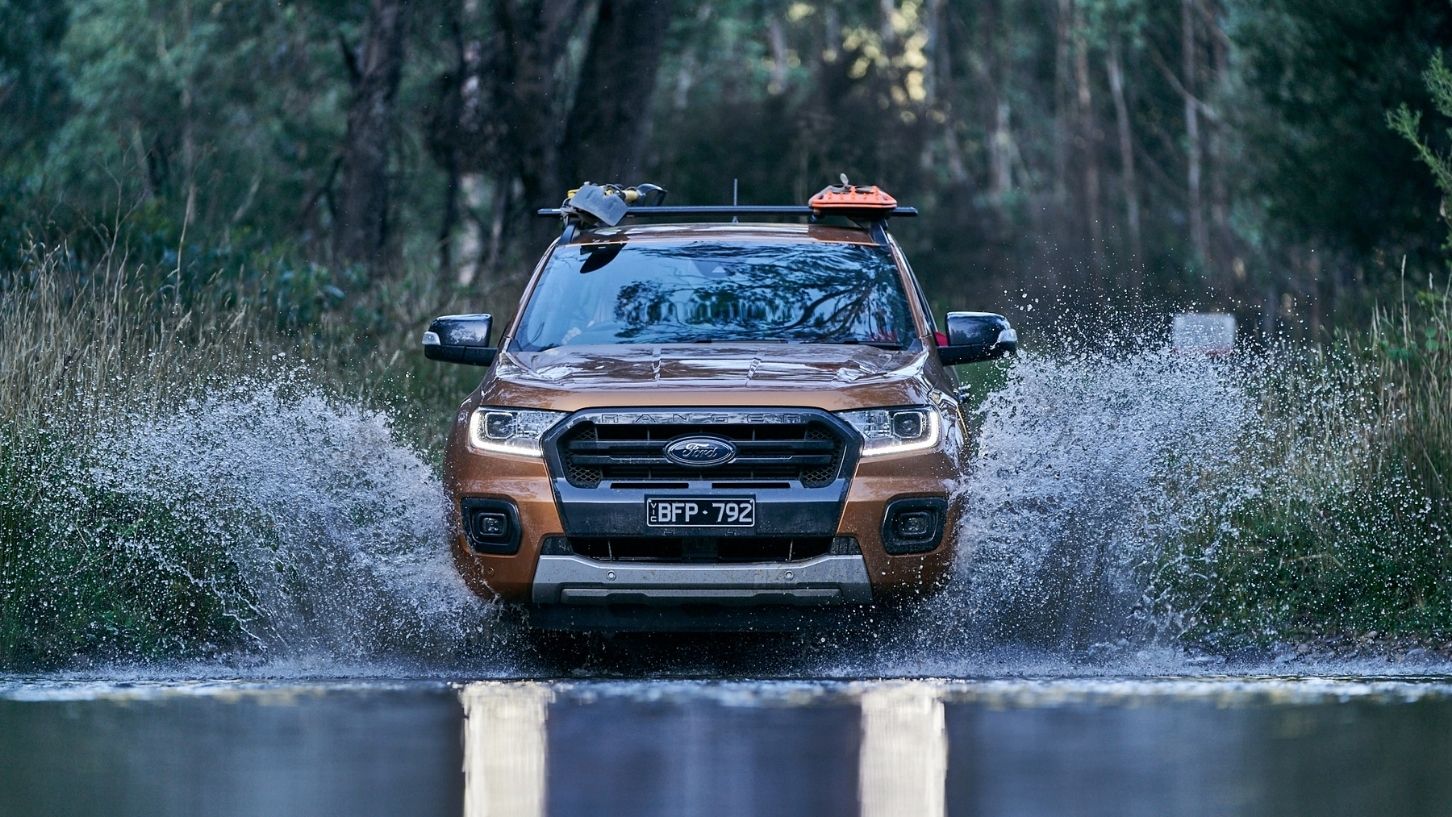
Unfortunately, even the most seasoned 4WD enthusiast gets bogged on occasion, and it’s bound to happen to everyone eventually, so don’t take it as a measure of your offroad ability and instead keep these following preventative tips in mind on your next off-road adventure:
Avoid sudden acceleration
When you’re driving off the beaten path, make sure to avoid making sharp turns and suddenly accelerating and braking, as this is a quick way to get yourself bogged. If you’re not familiar with the terrain you’re driving in, it pays to assess potential tricky locations before blazing down them.
Equip all-terrain tyres
Apart from ensuring you’re driving with the right tyre pressure, making sure you’re setting off with a set of high-quality all-terrain tyres will ensure your 4WD will have the required surface grip when things get messy. As opposed to standard road tyres, all-terrain or mud tyres feature wide and deep rubber grooves that allow mud and water to be efficiently expelled - rather than clogging up and preventing traction.
Take temperature into consideration when driving on sand
When 4WD driving on the beach, a common misconception is that you can lower the tyre pressure to 18psi and everything will be fine and dandy - this isn’t the case. Apart from factors like the type of vehicle you are driving and the total weight you are carrying, temperature is also a big factor with sand. A hot day will reduce the amount of moisture in the sand, making it much harder to drive through and requiring a lower tyre pressure for more grip. On the other hand, cool days will result in more moisture in the sand, giving the sand more stability and making it easier to drive on.
Remember to engage four-wheel drive
This one can be easy to forget, especially for people who spend a lot of time driving their 4WDs on bitumen. When driving off-road, you always need to remember to engage four-wheel drive. Also remember to lock the diff, as this will ensure all your wheels are spinning at the same time, ensuring your vehicle has full power when driving on difficult terrain.
Knowing how to extricate yourself from a rut in a stream, sand dunes, snow, mud or rocky terrain is an important part of developing your four-wheel-driving skillset. With a clear head and the right equipment, getting out of trouble is almost as easy as it is to get into trouble in the first place.
If you are new to the exciting world of 4WD driving, check out our 4WD basics and essential tips for beginners that covers everything you’ll need to know. If this isn’t your first rodeo, then make sure you’re kitted out with all the gear and supplies you’ll need by exploring our massive 4WD range.